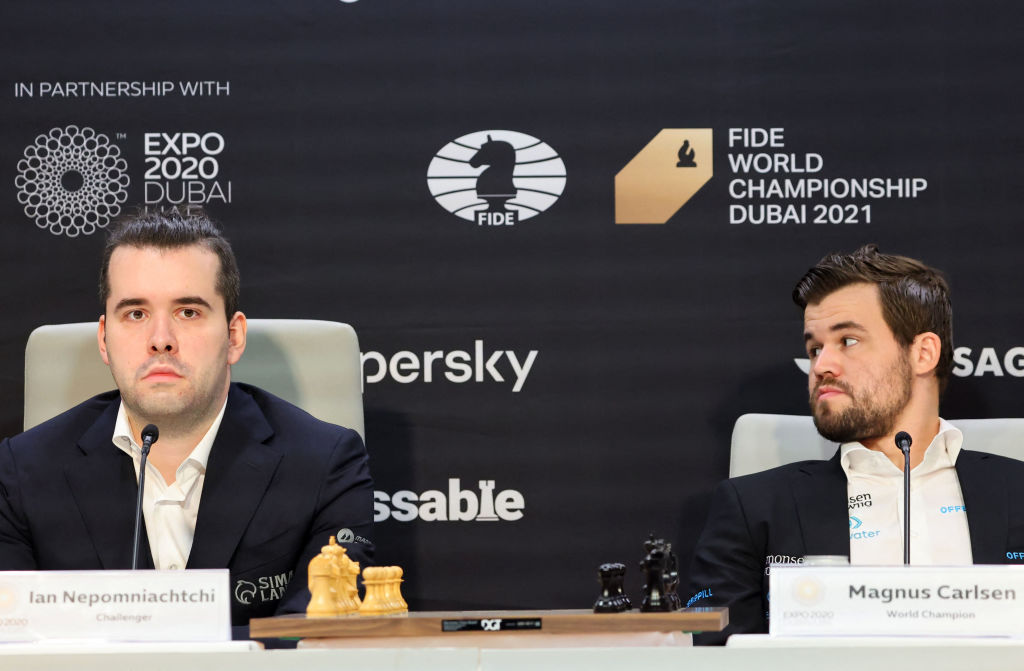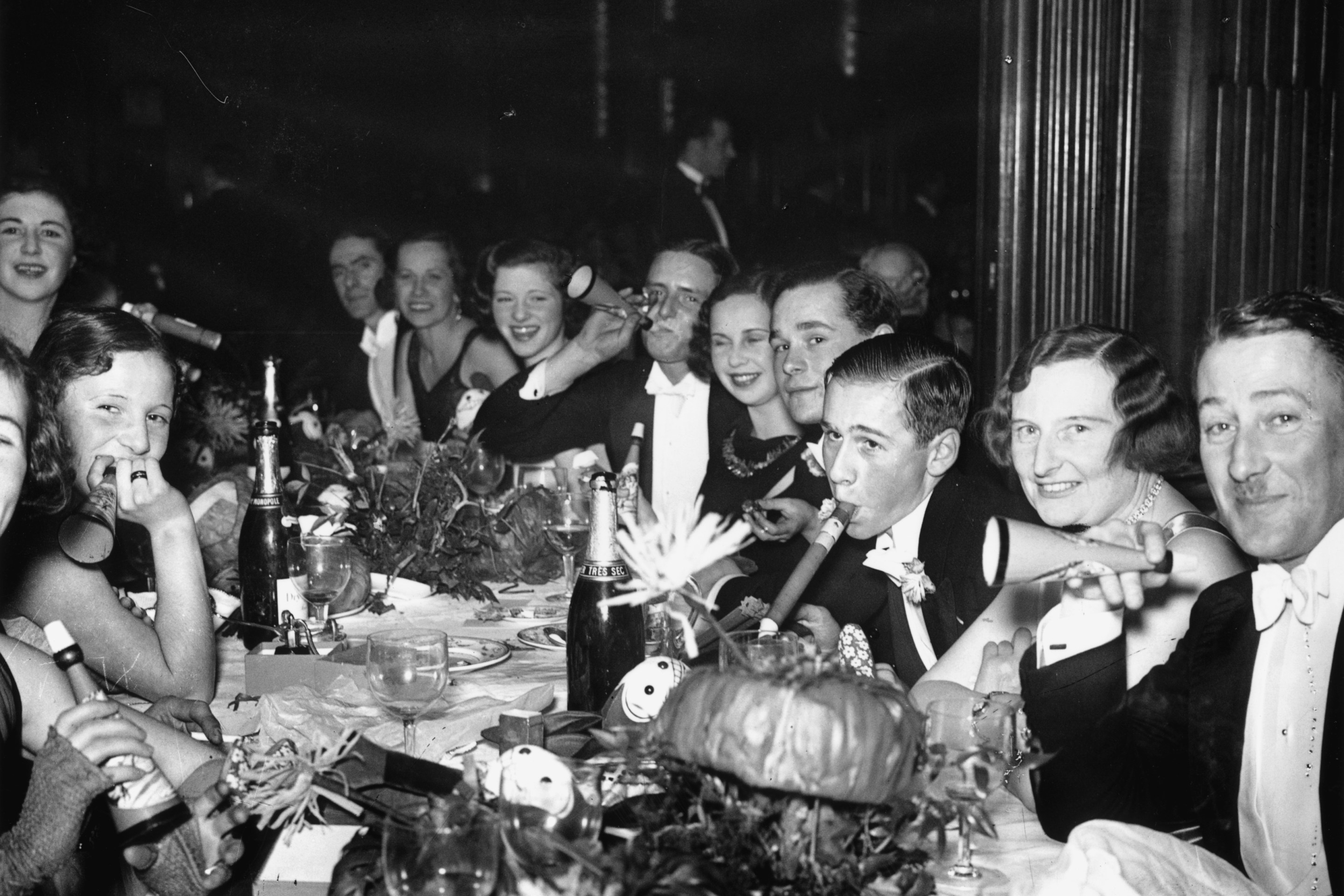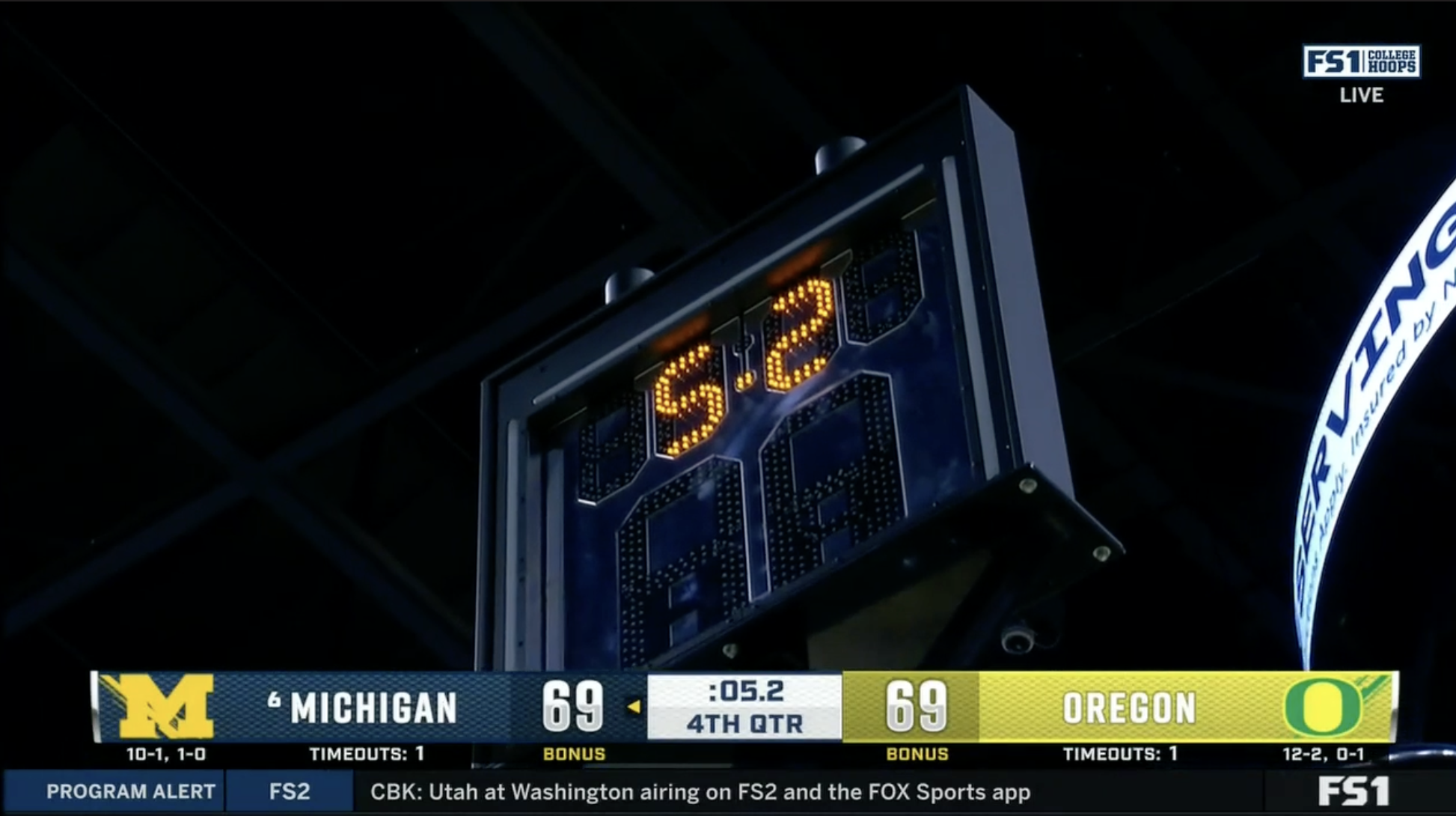It’s been the best of times, it’s been the worst of times, at the 2021 World Chess Championship. Defending champion Magnus Carlsen has taken a 2-0 lead after eight games of the 14-game match against challenger Ian Nepomniachtchi. Along they way, they've given us both some of the least and most interesting chess seen at the highest level in a long time.
Carlsen heads into the final stretch of the match very much in the box seat, with the challenger’s uphill battle all but guaranteeing that we’ll see fire on the board as he’ll need to throw everything at the champion in order to overcome the deficit.
Let’s recap the first eight games, using bold type to display moves that actually occurred in the games, and regular type to discuss hypothetical variations which did not. (And in case you missed it, check out our match preview.)
Game 1
Here we go! Three years and one pandemic after the last world chess championship, we’re on again! Ian Nepomniachtchi opened up with the White pieces, and, as expected, sent down his usual 1.e4. Magnus Carlsen responded with the solid 1…e5—not the attacking Sicilian Defense (1…c5), which we’d seen in all six of his Black games in the 2018 world championship—and Nepo continued with 2.Nf3 Nc6 3. Bb5, the Spanish or Ruy Lopez opening. The chess nerds of the world held our hearts in our mouths to see whether we would be laden with another world championship match heavily featuring the Berlin Defense (3…Nf6), before, thankfully, we dodged that territory with the simple 3…a6.
A few moves later we had our first critical moment. After Nepomniachtchi avoided the Marshall Attack (Frank Marshall reportedly kept the novelty 8.c3 d5! under his hat for nine years before uncorking it for the first time against José Raúl Capablanca in 1918; Capablanca nevertheless found a way through the complications and won), Carlsen played the surprise knight a5:
That’s a bold pawn sacrifice, inviting White’s horsey to jump in on e5, while planning to chop White’s b2 bishop, leaving Black a pawn down but with the bishop pair against White’s bishop and knight. Here Carlsen telegraphed his intention to play a long, grinding game, betting that his positional acumen (at the highest level, a bishop pair is a better army than a knight and bishop) would prove superior in the long run.
The move was a novelty which hadn’t previously been played over the board between Grandmasters, but Nepo was prepared for the variations which followed, and quickly continued by accepting the pawn. The queens came off the board on move 15, and Nepomniachtchi managed to trade both pairs of bishops nine moves later, with Nepo nursing a slight advantage. A critical moment came on move 33, where Carlsen came up with a resourceful plan starting with b4:
His idea is to trade pawns on c3, and then to pile his rooks onto that b3 pawn, which would even up the material balance but leave Black with an invasive attack. Nepo calmly found the correct response, giving back the pawn starting with king e2, and ultimately bringing him across to c2, where he could act as another defender to Black’s rooks’ entry points on the b-file.
The players shook hands for a draw eight moves later, with Nepomniachtchi relieved to get through his first game on chess’s biggest stage intact, and Carlsen happy to have put the challenger under some pressure and to ultimately secure a draw with the Black pieces.
Game 2
What would Magnus Carlsen break out in his first game with the White pieces? Having transitioned from the too-cool-to-study-opening-prep persona of his early career to now being arguably the world’s foremost opening theoretician, Carlsen’s opening choices make waves in the world of chess at large. Here, he opted for 1.d4, and, with the challenger not going with his favourite Grünfeld Defense, Magnus went with 4.g3, the Catalan, an opening he’s rarely played in his career:
We got a cool theoretical debate out of the opening, before the players trundled to a double-edged middlegame. Carlsen looked to have everything under control, before he played a loose move: knight to e5?
Oh dear! Let’s work this through: Black’s knight on d3 is already a monster (there are no pawns around to attack it), and so to preserve it, Black starts by taking the e5-knight with its bishop, and after White recaptures with the pawn, the knight from a6 jumps to c5!. Now Black has a 4-2 pawn majority on the kingside, with more trades to follow and its second knight ready to invade the White position. It won’t help Black to exchange knights on c5 (the second Black knight would then be ready to eat White’s a4 pawn), and so (with a presumed shrug of the shoulders), Carlsen went for chaos with knight d6?!, ready for the response knight b3!.
No thanks—I wouldn’t want to play this position against a man who has a 4-1 lifetime career record against me. Carlsen immediately bit the bullet and gave up the exchange, allowing Nepo to capture his bishop and one rook in exchange for both of his horseys. That octopean knight on d6 remained the pride of White’s position, and kept Carlsen in the fight.
Nepomniachtchi was in the driver’s seat, but Magnus’s resourceful counterplay led Nepo to make a pawn sacrifice on move 24 which turned out to be objectively unnecessary. Nepo was eventually forced to give back the exchange and trade one of his rooks for Carlsen’s d6 knight, and the players traded down into a drawn rook endgame, and the players agreed a draw on move 58.
After a brief passage of genuine tension, the world champion had managed to defuse the challenger’s grip on Game 2. Again, both could take positives away from the game: Nepomniachtchi in that he had been clearly better during the middlegame, and Carlsen that his counterattack had spooked Nepo into giving away his advantage.
Hey—want to see something cool? It’s quite common for chess players to sit and discuss the game they’ve just played right after finishing, discussing hypothetical variations and exchanging evaluations of the various positions. Despite (in this case) still having 12 more games to play against each other in this match, there isn’t much bluffing or chest-beating, as the players give an honest account of where they thought the game turned. Check out this video of the players discussing Game 2:
Game 3
Ian Nepomniachtchi again had the White pieces in Game 3, and we again got 1.e4, followed by an Anti-Marshall Spanish. This was the first of three successive games that gave us a whole lot of not very much at all, as both players came incredibly well-prepared. Nepo was not overly adventurous, while Carlsen managed to keep the game solid and did not allow Nepo an inch of room to eke out any sort of advantage.
It was boring as hell, is what I’m saying! Queens came off the board on move 24, and while each side had an extra pawn on opposite sides of the board, the game soon traded into a dead-drawn same-colored-bishops endgame. I won’t waste your time by saying any more about it. The players agreed a draw on move 41, the earliest point permitted under the regulations. The players headed into the first rest day with the scores level.
Therefore, before we move on, let me throw in some assorted big-picture observations on the match:
- Magnus has adopted a superstition of wearing light suits for his games with White, and dark suits for his games with Black.
- Our man Nepo spends a lot of time away from the board, chilling in the neutral rest area, where he can look at the position on the board on a screen. When back at the board, he sits on his chair with one leg folded under him, like a damn kid!
- Chess.com’s coverage featured absolutely the worst and cringiest thing I’ve ever seen: an execrable chess-themed “improvise[d] rap” (they’ve never heard of the word “freestyle”?) by some rapper named Harry Mack, who was reading the entire thing from his notes and not improvising.
- The players apparently requested that the temperature in the playing area be set at 23 degrees Celsius/73.4 degrees Fahrenheit.
On to Game 4 we go. Oh, but first—Magnus was tapped on the shoulder for a random drug test after the game. In chess! What a world.
Game 4
It was Magnus Carlsen’s 31st birthday on the day of Game 4. He sewed up the 2016 world championship in tiebreaks on the day he turned 26, but there was to be no repeat on this day.
Carlsen switched to 1.e4 for his second White game, indicating that he may adopt the same strategy as in the 2018 world championship, where he cycled through e4, d4, and c4 for his opening moves with White. How would the challenger respond? After 1…e5 2.Nf3 Nf6 we had the Petroff Defense—not Nepo’s usual setup with Black, but a choice that Carlsen was prepared for.
The players sped through a long theoretical line, showing that both were booked up to the eyeballs on the line played on the board. After queens were exchanged on move 17, we had an interesting moment:
This is a good time to revisit the en passant rule: after Black plays pawn to a5, White’s b5 pawn is permitted to capture it by moving diagonally to a6—i.e., to the vacant square that it passed over, not to the square that it landed on. The rule permits this type of capture, but only on the move immediately following the pawn’s double-hop. If you choose something else on the next move, the right to capture on the vacant square vanishes. Carlsen elected not to eat the pawn, but to unleash some further preparation with knight h4, a cool move intending to re-route the knight through g2 and f4 to attack Black’s d6 pawn.
Potential pitfall: Punting on picking off the pawn en passant produced a protected passer on the precipice of promotion—a positional problem. The newfound mobility of White’s knight was offset by the threat represented by Black’s flank pawn, and Nepo marched his little guy down the board in demonstration that the dynamics of the game were balanced.
Carlsen spent a lot of time at the board calculating the lines that would follow, but couldn’t find a clear path to victory, even with Black’s knight ultimately caught in an awkward and unproductive spot on f8. Nevertheless, there was no lasting advantage to be found, and so Carlsen acquiesced to manufacturing a draw by repetition at move 33.
Another game that, while obviously played at a high level with some fantastic preparation, was largely a snoozer for the fans. On to Game 5!
Game 5
Ian Nepomniachtchi once again opened up with 1.e4, and Magnus Carlsen responded with another Anti-Marshall Ruy Lopez. The players once again entered theoretical waters, and arm-wrestled their way to a middlegame where Nepo had a mini-edge which he couldn’t turn into a pressing advantage, and Carlsen was managing to hold without being able to equalize.
Queens came off on move 24, and we had a symmetrical position where material was equal White owned the a-file, and Black had control over the b-file. Nepo was threatening to put pressure on Magnus’s king, but the champion managed to build the following fortress, which couldn’t be breached:
(Quick note: in any situation such as this, it’s now standard for people to troll Magnus by crowing that he once said that he doesn’t believe in fortresses in chess. His actual quote, after Game 4 of the 2016 world championship, was: “In general, I’m not a big believer in fortresses in chess,” and was the beginning of an explanation of why he couldn’t break down the fortress that his opponent Sergey Karjakin had established in that game.)
And so, after a draw by repetition on move 43, it was at about this point in the match that I was pretty much ready to take my bishop and go home. It seemed that both sides were so well prepared that neither was likely to be able to eke out an opening advantage without playing some hugely unexpected sideline from the fringes of theory, but that neither player was prepared to be the first to take any meaningful risk. There's nothing wrong with draws in chess in a vacuum—I enjoyed most of the all-drawn 2018 world championship, which was a tense rollercoaster in which the high points outshone the dull points—but the match so far had mostly been booooo-ring, with neither player looking likely to blink first. Again, it appeared that we were destined for an inexorable march to a full slate of draws and an unsatisfying tiebreak finish.
Thankfully, that’s not what occurred.
Game 6: Carlsen 1-0 Nepomniachtchi
Ah, Game 6. A true classic in its own right, and potentially the game that single-handedly saved classical chess as a format for deciding the world championship. In case you missed it, check out Mr. Redford’s recap of this absolute epic.
Carlsen, with the White pieces, again opened with 1.d4, and we got another Catalan. Carlsen dished up a novelty by offering a pawn on move 9, but Nepomniachtchi (still also in his preparation) wisely declined to accept, and the challenger soon had a pleasant position with both of his bishops staring down the long diagonals toward White’s king. Optimistic that he might be able to fight for a famous win, Nepo declined to pursue a queen trade on move 17, and on move 25 made a move which altered the course of the game and match.
Rook from a8 to c8 offered Magnus an intriguing middlegame choice which he couldn’t pass up: to trade his queen for both of Black’s rooks, creating an imbalanced position where it would be totally unclear which side would emerge on top. According to the non-scientific rule of thumb used as a guide by beginners and grandmasters alike, a rook is worth five points, and a queen is worth nine points. This type of trade is usually seen as roughly value-neutral, since the rooks can coordinate to attack or defend a target twice, but take longer to manoeuvre around the board and can often get in each others’ way.
It must be said that in the abstract, this was a risky move from Nepo, and one which (although hindsight is 20-20) ultimately backfired. Carlsen is the greatest positional player in chess history, and he’d been continually frustrated at being held in a straitjacket of solidity throughout the first five games of this match (not to mention carrying the memory of not being able to win a game in the 2018 match). It was a huge risk for Nepo to take him on in this middlegame, especially when he had other continuations open to him. In the end, gauntlet thrown down, the champion did not disappoint.
Therefore, we (finally) had a rich position on the board, where each side had the freedom to demonstrate why their position was superior. In the insane complications that followed, both players were eating up scores of time on their clock, with Carlsen down to about four minutes for his last 10 moves before getting bonus time at move 40 (with no increment added to his clock under the 2021 championship’s new rules). The dam was threatening to break, before the players traded blunders (in this case a relative term, when we’re discussing such high-level play) in close succession, leaving Black on top.
In severe time pressure, Nepo squandered his advantage by twice in a row declining to capture White’s passed b-pawn, taking advantage of the pin on the White knight:
Pawn to e5? was followed by rook to c2, and Nepo again declined with capture with queen d5?. Black would round up that pawn a few moves later, but the White cavalry had by then coordinated, and were able to euthanize White’s a-pawn before turning their attention to Black’s king. Picking up the pawn earlier might have allowed Nepo some greater chances at neutralizing counterplay.
Carlsen then set about demonstrating why he’s the highest-rated player of all time, as his pieces danced and weaved about the board, as Nepo heroically tried to craft a winning attacking plan. Despite our silicon friends declaring that the position bore no more than rough equality or a slight advantage for White, through human eyes the position became increasingly tilted in Carlsen’s favor, before on move 79 the champion was ready to cash in:
Rook takes on f5!, was followed by queen to d3! (a great move by Nepo, threatening bishop takes e3, check, where neither rook can recapture since they are defending one another), and then the fork rook takes on f7, check!, where after king takes rook Magnus played rook to b7, check!, picking up the a7 bishop next move. Carlsen had traded a rook for two pawns and a bishop, resulting in an endgame of queen and pawn versus rook, knight, and three pawns.
Supercomputers declared that the position was theoretically drawn, but it was almost impossible for Black to defend in an over-the-board game against the best player in the world. Magnus masterfully and patiently weaved an attacking web, parrying Nepo’s frantic checks and marshalling his forces before triumphantly beginning his pawns’ march toward the helpless Black king. (It’s a fun game to click through, which you can do here.)
It was a slow and tantric dance with Carlsen deliberately trying to prolong the game in order to prey on Nepo’s nerves and physical fitness in order to elicit a mistake. The players eventually passed the 100-move mark, and then the milestones began to fall: At move 124 it became the longest-ever game in world championship history, while after seven-and-a-half hours the clock struck midnight, making it the first world championship game to ever run into the next morning.
It was a tour de force by the world champion, and a Herculean defensive performance by Nepomniachtchi, who resisted Carlsen’s attack longer than just about any other player would have. At long last, on move 136, after seven hours and 47 minutes, in the following position, Nepo resigned:
White’s king, now shielded by the knight, will get to f8 to support the e-pawn’s promotion, with any of White’s pieces ready to commit seppuku in order to terminate or distract the Black queen.
An incredible game, one of the greatest in world championship history. With the victory, Magnus Carlsen broke his streak of 19 world championship draws in a row, won his first world championship game since 2018, and took the lead in a world championship match for the first time since 2016. Ian Nepomniachtchi, for his part, made the crucial decision which gave us this most memorable of games, for which we should be thankful. He took a calculated risk which didn’t come off—he may regret the decision to enter that materially unbalanced middlegame, but at least he’ll never die wondering.
Cruelly for Nepomniachtchi, this was the first of three consecutive gamedays, meaning that after fronting the press conference, the players (still full of adrenaline) would desperately need to try to get some sleep, in order to be up in time to prepare for the next game. How would the players respond?
Game 7
Coming off the epic Game 6 loss, Nepomniachtchi opted for a professional approach in Game 7: to achieve a painless draw with the White pieces, regroup, get some sleep, and come back fighting the next day. While it would be a pity to waste a game with White, the physical and mental exhaustion of the previous (and same!) days’ play could mean that things could go downhill fast if he was to play loosely.
Nepo again went with 1.e4, and we had another Anti-Marshall Spanish. Absolutely nothing of note happened in the game: All the minor pieces were traded by move 25, the queens were gone three moves later, and by move 30 we had a symmetrical rook-versus-three-pawns endgame which I reckon even I could hold against Magnus Carlsen. All that was to be done was for the players to sleepwalk their way into a threefold repetition at move 41, and hands were duly shaken for a draw.
For Nepo: a good and professional result. He’s got a bit of a reputation for falling apart in the latter half of tournaments if things aren’t going his way. Yes, he won the 14-round Candidates’ tournament to qualify for this match, but that was postponed at the halfway point for more than a year, meaning it essentially amounted to two seven-game tournaments. Therefore, taking an easy draw was a good result. Now to hit the hay, get some sleep, and come back refreshed for Game 8. Let’s see how that goes!
Game 8: Carlsen 1-0 Nepomniachtchi
Tilting in chess is a real phenomenon.
Game 8 started out fairly well for Ian Nepomniachtchi. After Nepo repeated the Petroff Defense that we’d seen in Game 4 (also appropriately known as the Russian Defense), Magnus varied his approach with 3.d4 (rather than 3.Nxe5), and then uncorked a bit of move-order trickery to put Nepo out of book by move 9 in a perfectly symmetrical position. After thinking for 16 minutes, the Russian found a move which appears to have been missed by both the engines and Magnus’s team: h5!
This stops the White queen from coming to h5 herself (which would threaten f7, h7, and the pawn on d5), and lays the foundations for one day perhaps launching an attack on the White king. The move caused the champion to sink into a tense 40-minute think, clearly frustrated that this move both appeared good (it was) and had eluded his team’s preparation. Not being able to find a way to keep a healthy advantage, and exhausted from the previous days’ games, Carlsen made a move which essentially amounted to a draw offer: queen e1, check. He expected a response of queen e7 and a trade of queens, leading to another early bedtime for both players. Instead, Nepo inexplicably decided to keep the game alive with king f8?.
While not a disastrous move objectively speaking, from a subjective point of view Ian should have taken the opportunity to force a quick draw with the Black pieces, enjoy his rest day, and come back swinging with White. Instead, Magnus got to keep the queens on the board, and make some fun maneuvers with a slight edge, before Nepomniachtchi made a capital-B Blunder on move 21 with pawn to b5??.
Guess the move for White!
This one wouldn’t be out of place in a beginner’s tactics manual: Carlsen simply had to find queen a3, check!, and after king g8 Carlsen picks up the a7 pawn with his next move. Black’s b5-pawn can’t then profitably take the c4 bishop, since the d7 bishop is also hanging—the detail which Nepo stated in the press conference that he’d missed. (If Black had responded to the check with queen d6, after taking the pawn White would also threaten mate-in-3 on the back rank beginning with queen a8, check.)
This is the kind of blunder that you or I would be disappointed with, let alone if it were made by the world championship challenger. That may sound harsh, but the man himself agreed, describing his play in Game 8 as “below a GM level."
At the highest level, an advantage of a clean pawn can be all the difference, and the rest of the game was simply Carlsen playing with his food, as the blunder left Black having no compensation for the lost pawn. Nepo was clearly below his best and still reeling from the Game 6 loss, his misery compounded by making such an elementary mistake on chess’ biggest stage. Carlsen soon forced trades into a queen-and-pawns endgame, quickly won a second pawn, and danced around the board increasing his advantage, before Nepo resigned in the following chef’s kiss of a position:
How about that for an image of absolute picturesque domination: White’s queen is protecting all four of her pawns, and attacking Black’s only footsoldier; Black can do nothing more but give one or two spite checks in response, with its king stranded all the way up on h7.
And so, on we march. There are six more games to go: time for Nepomniachtchi to strike back, but no time for him to muck around in doing so. Only Max Euwe in 1935 (down 5-2 after nine of 30 games against Alexander Alekhine) and Bobby Fischer in 1972 (down 2-0 after forfeiting the second of 24 games against Boris Spassky) have ever recovered from two or more games down to take the title in a world chess championship.
Nepo will need to either tie up the match or go down swinging. Therefore, I’d be flabbergasted if we don’t immediately see a departure from his conservative opening choices, opting for more risky but potentially double-edged play. Realistically, the ultimate result is not now in doubt, but we should get some very entertaining play over the final games. Could we see the first King’s Gambit in a world championship game since 1910?
We’re set up for a barnstorming finish to the World Chess Championship, folks! Let’s go!







